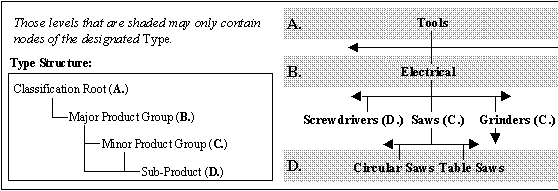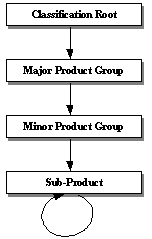In some instances, the depth of the hierarchy may vary. Not all hierarchies are suited to a formal type of structure discussed in the Fixed Hierarchy Structure topic in this documentation here. Some groups of Products do not require four levels. There may be so few Products in certain groupings that three levels of hierarchy are preferred. Therefore, the structure of the hierarchy needs to be flexible enough to accommodate this.
For example, the leaf nodes are of the same object type, but may be created in different levels. This is accomplished by allowing an object type to have multiple parents and displayed in the figure below.

The two views represent the same object type structure. In this example, when creating a node below a node of the object type Major Product Group, it is possible to create a node of the object type Minor Product Group or of the object type Sub-Product.
If a Minor Product Group is created, it is then possible to create a child node of the object type Sub-Product also. No matter where in the hierarchy the node of the object type Sub-Product is created (below Major Product Group or Minor Product Group), it is a leaf node because it is not possible to create any nodes below a Sub-Product.
The following figure represents a hierarchy based on a varying object type structure.

Multiple Parents
A node of the object type Major Product Group can have children of either the object type Minor Product Group or Sub-Product. For example, the node Screwdrivers is of the object type Sub-Product and Saws is a Minor Product Group. A node of the object type Minor Product Group can only have children of the object type Sub-Product.
The object type hierarchy can be structured so it allows an object type to become a child of itself. This causes a situation in which a leaf node can never be created in the corresponding Product or Classification hierarchy, because when a node of the recursive object type is created, a child node of the same object type can always be created as displayed in the figure below.
